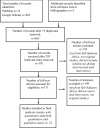Condom use and risk factors of inconsistent or low use of the condoms during heterosexual anal intercourse in sub-Saharan Africa: a scoping review
- PMID: 36032479
- PMCID: PMC9382482
- DOI: 10.4314/ahs.v22i1.3
Condom use and risk factors of inconsistent or low use of the condoms during heterosexual anal intercourse in sub-Saharan Africa: a scoping review
Abstract
Background: Anal intercourse (AI) has been reported to be the riskiest among other sexual intercourses in spreading human immunodeficiency virus (HIV) and the risk could be minimized by the use of condoms. Whilst AI is believed to be practised mainly by men who have sex with men, AI has also been reported to occur in heterosexual relationships. However, data on condom use during heterosexual AI are inadequate in sub-Saharan Africa.
Method: A scoping review of English language published articles on condom use during heterosexual anal sex, whose studies were conducted in Sub-Saharan Africa from January 2010 to May 2020 was conducted. Articles were searched systematically on PubMed and Google Scholar electronic databases. Heterosexual AI was defined as penile penetrative anal sex between a man and a woman regardless of the sexual orientation of the 2 parties involved in the act of heterosexual AI.
Findings: A total of 21 studies were eligible for analysis. Most of the studies (17 out of 21) reported females to be involved in heterosexual AI whilst 9 out of 21 studies reported males to be involved in heterosexual AI. The lifetime prevalence estimate of condom use during heterosexual AI ranged from 29%-97.5%. Other prevalence estimates of condom use during heterosexual anal intercourse were reported over various recall periods which were: 12 months' recall period with prevalence estimates ranging from 2.9%-59%; prevalence estimates for the past 3 months which ranged from 50%-94.4%; 1 month's recall period with prevalence estimates ranging from 5%-96% and prevalence estimates for the last intercourse experienced ranging from 1%-55%. Condom use during heterosexual AI was generally low and/or inconsistent among female sex workers (FSWs), men who have sex with men and women (MSMW) and some women in the general population. There were no risk factors identified in the study for the inconsistent or low use of condoms during heterosexual AI.
Conclusion: Evidence from this study suggests condom use during heterosexual AI could be fairly low especially among groups such as FSWs, MSMW and some women in the general population. Risk factors for using condoms inconsistently or using condoms less during heterosexual AI are not clear. Heterosexual anal intercourse and condom use during the AI practice is generally an under-studied subject in Sub-Saharan Africa. Future studies need to explore on heterosexual AI and condom use practices during AI comprehensively so that there can be concrete evidence on the subject which will inform targeted interventions aimed at reducing HIV among heterosexual populations in SSA.
Keywords: Heterosexual anal intercourse; condom use; sub-Saharan Africa.
© 2022 Nyoni P et al.
Figures
Similar articles
-
How common and frequent is heterosexual anal intercourse among South Africans? A systematic review and meta-analysis.J Int AIDS Soc. 2017 Jan 12;19(1):21162. doi: 10.7448/IAS.20.1.21162. J Int AIDS Soc. 2017. PMID: 28364565 Free PMC article.
-
Condom use in anal intercourse amongst people who identify as homosexual, heterosexual or bisexual.N Z Med J. 1992 Jul 8;105(937):262-4. N Z Med J. 1992. PMID: 1620511
-
Promoting safer sex in the context of heterosexual anal intercourse: A scoping review.J Clin Nurs. 2021 Aug;30(15-16):2111-2130. doi: 10.1111/jocn.15628. Epub 2021 Jun 13. J Clin Nurs. 2021. PMID: 33377555
-
Inconsistent condom use by male clients during anal intercourse with occasional and regular female sex workers (FSWs): survey findings from southern states of India.BMJ Open. 2014 Nov 19;4(11):e005166. doi: 10.1136/bmjopen-2014-005166. BMJ Open. 2014. PMID: 25410604 Free PMC article.
-
Sexual relationships, risk behaviour, and condom use in the spread of sexually transmitted infections to heterosexual men.Genitourin Med. 1997 Oct;73(5):368-72. doi: 10.1136/sti.73.5.368. Genitourin Med. 1997. PMID: 9534746 Free PMC article.
Cited by
-
Comparison of human immunodeficiency virus-related risky sexual behaviors between men who have sex with men only and men who have sex with men and women: A cross-sectional study in Eastern China.Prev Med Rep. 2024 Oct 30;48:102923. doi: 10.1016/j.pmedr.2024.102923. eCollection 2024 Dec. Prev Med Rep. 2024. PMID: 39555239 Free PMC article.
-
Optimizing the pipeline of multipurpose prevention technologies: opportunities across women's reproductive lifespans.Front Reprod Health. 2023 May 30;5:1169110. doi: 10.3389/frph.2023.1169110. eCollection 2023. Front Reprod Health. 2023. PMID: 37325241 Free PMC article. Review.
-
Sexual reproductive health, NCDs and infectious diseases.Afr Health Sci. 2022 Mar;22(1):i-v. doi: 10.4314/ahs.v22i1.1. Afr Health Sci. 2022. PMID: 36032436 Free PMC article. No abstract available.
-
HIV prevalence and factors associated with HIV positivity among Black people in primary care in Porto Alegre, Brazil, 2020-2022: a cross-sectional study.Epidemiol Serv Saude. 2025 May 12;34:e20240014. doi: 10.1590/S2237-96222025v34e20240014.en. eCollection 2025. Epidemiol Serv Saude. 2025. PMID: 40366938 Free PMC article.
References
-
- The joint United Nations programme on HIV/AIDS. Global HIV statistics [fact sheet] 2019.
-
- Kilmarx PH. Global epidemiology of HIV. Curr Opin HIV AIDS. 2009 Jul;4(4):240–246. - PubMed
-
- Laar MJ van de, Likatavicius G, Stengaard AR, Donoghoe MC. HIV/AIDS surveillance in Europe: update 2007. Eurosurveillance. 2008 Dec 11;13(50):19066. - PubMed
-
- Schmid GP, Buvé A, Mugyenyi P, Garnett GP, Hayes RJ, Williams BG, et al. Transmission of HIV-1 infection in sub-Saharan Africa and effect of elimination of unsafe injections. The Lancet. 2004 Feb 7;363(9407):482–488. - PubMed
Publication types
MeSH terms
LinkOut - more resources
Full Text Sources
Medical
Research Materials
Miscellaneous

